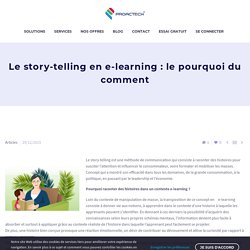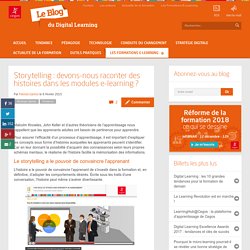

Krisztina Szerovay. Le story-telling en e-learning : le pourquoi du comment. Le story-telling est une méthode de communication qui consiste à raconter des histoires pour susciter l’attention et influencer le consommateur, voire formater et mobiliser les masses.

Concept qui a montré son efficacité dans tous les domaines, de la grande consommation, à la politique, en passant par le leadership et l’économie. Pourquoi raconter des histoires dans un contexte e-learning ? Loin du contexte de manipulation de masse, la transposition de ce concept en e-learning consiste à donner vie aux notions, à apprendre dans le contexte d'une histoire à laquelle les apprenants peuvent s’identifier. En donnant à ces derniers la possibilité d’acquérir des connaissances selon leurs propres schémas mentaux, l’information devient plus facile à absorber et surtout à appliquer grâce au contexte réaliste de l’histoire dans laquelle l’apprenant peut facilement se projeter.
Notre cerveau est plus actif quand on raconte des histoires. Storytelling : faut-il raconter des histoires en elearning ? Malcolm Knowles, John Keller et d’autres théoriciens de l’apprentissage nous rappellent que les apprenants adultes ont besoin de pertinence pour apprendre.

The Power of Storytelling in eLearning by Jennifer Neibert. “What would happen if we took a deep breath, stepped away from the storyboard, and crafted a fascinating narrative to guide our learners?

One that our learners felt and experienced on an emotional level; that elicited a response to go, or change, or do; and above all, that resulted in the meaningful change we’re really seeking—now that’s a powerful tale!” Before diving into this article, stop and think for a moment about the last time you saw a film or documentary that impacted you in some way. Then, think about what made it so. Perhaps it was the scenery or location. Or maybe the characters seemed relatable, compelling, or provocative. As instructional designers and eLearning developers, we often get caught up in the intricacies of our work—learning objectives, evaluation methods, style guides, and so on. Why You Need To Use Storytelling For Learning. SumoMe I’m sure you’ve heard by now that storytelling can make learning more effective.

Stories help us process and remember information. Perhaps they even touch a part of our consciousness associated with the magic and creativity of childhood. In my desire to become a better storyteller, I attended a session on the subject while at the Presentation Summit, a conference where the topics overlap surprisingly well with the interests of training professionals and learning specialists. Here are the key points I gathered from a session titled, The Art of Storytelling, presented by Jon Thomas. 1. Much of what people remember from a learning experience are the feelings of the underlying message rather than a multitude of small facts (which are better reserved for job aids). 2.
Any kind of presentation—whether it be online training or a live presentation—will benefit from a story construction. 3. When we watch or read about a superhero, we always remember the person’s origins. 4. 5. 6. Story-Based Learning Strategy In A Course For Instructional Designers. My father was a master storyteller.

He had a dual major in History and Education (specializing in teacher training) and used his storytelling skills to weave narratives with learning. Storytelling in eLearning: The why and how. Every year, I have to complete training related to confidentiality policies (as a learner, not an as the instructional designer).

Most years, I think of the training as time wasted—I already know that I'm not supposed to blab confidential information to my friends and family. But last year, the training instructor opened with a story about a confidentiality breach caused by an employee checking his email in a cafe. As someone who often works on the go, that got my attention. Boring to Brilliant: 5 Tips to Convert Your E-Learning to a Story-based Approach. When consulting, I try to explain that simply exporting a PowerPoint presentation and calling it “e-learning” doesn't necessarily qualify it as e-learning.

It’s not instructionally sound; it’s simply words, some large, some small, and often irrelevant photos or bad clip art, all minus the context. Without an instructor to flesh out the material or to add their own teachable stories to the content, learners may find nothing relevant, so they largely tune it out. Education presented in this manner produces little to no ROI. But there is a better way. Storytelling has been powerfully educating humans for millennia. 1. 2. 3. Advertisement. Use Stories in eLearning: 6 Tips to Bring Out Your Inner Storyteller. Stories have captivated us as a species since the dawn of man.

Through stories, we have passed on traditions, remembered the past, and carried information across the millennia. And it's not just our ancestors who harnessed the power of stories, either. Stories still work to reach people, which is why we see businesses turning to the power of storytelling in branding efforts, marketing campaigns, corporate strategies, and even eLearning courses and business presentations. The Power of Stories Stories hold this power over our minds and hearts for a reason. In short, we still need stories to make sense of the world and our place in it. Infusing stories into eLearning courses will increase the power of content and help the learner retain information better than other formats.
7 Tips To Integrate Storytelling Into Your Next eLearning Course. This article will help you integrate storytelling in your eLearning design and development process in order to create a highly effective and engaging eLearning experiences for your learners.

There are a number of reasons why storytelling is so effective in eLearning. Not only does it help to motivate learners and create a more immersive experience, but it also allows them to feel more emotionally connected to the subject matter. The trouble is that converting your content and topics using a storytelling strategy can be challenging, especially if you want to get maximum results from your efforts.